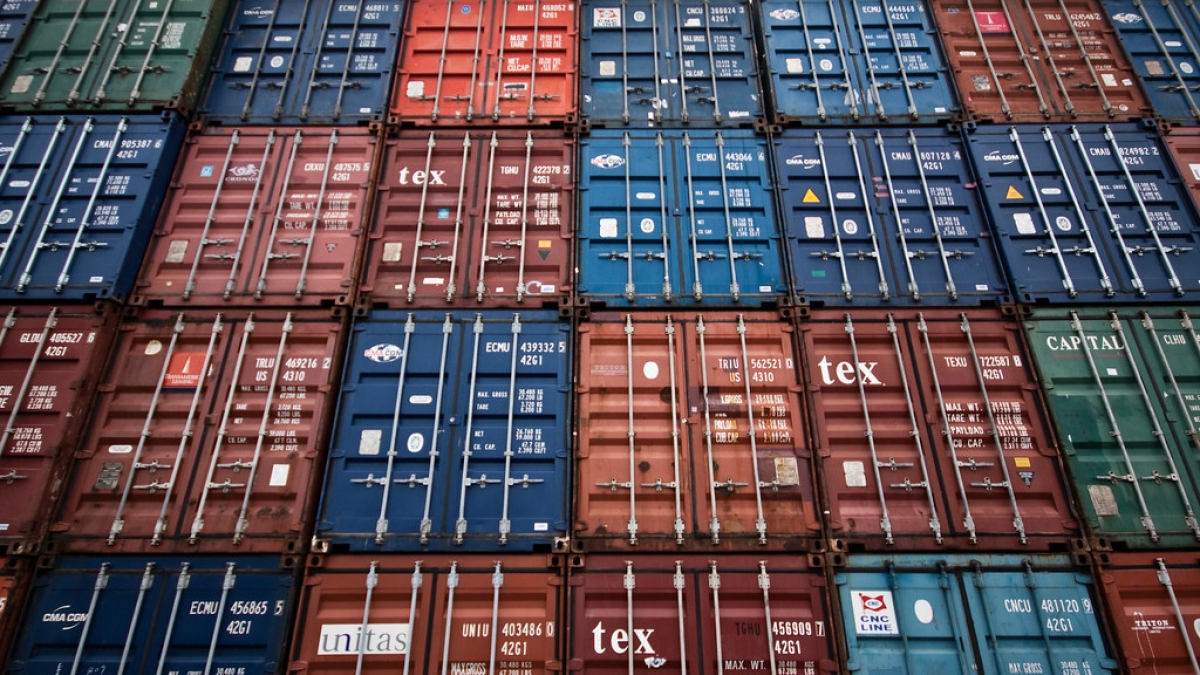The United States and China are expected to sign a historic agreement on Wednesday, Jan. 15, addressing trade issues that have been brewing for some time.
After nearly 18 months of verbal jousting and tariffs on goods worth hundreds of billions of dollars, the two economic powerhouses have finally come to the table.
U.S. President Donald Trump has leveled charges in the past that China has engaged in unfair trade practices, including the theft of intellectual property. China has stated that Trump is trying to destabilize its economy.
The Wednesday signing will focus mainly on advances in intellectual property protection, high-dollar farm purchases and a reduction in barriers to exports. Critics and pundits say it’s simply Round 1 in a trade war that isn’t over, but it's certainly a step in the right direction. As always, the devil is in the details.
Perhaps no one person in academia knows those details better than Arizona State University’s Mary B. Teagarden, who has been doing research on China since 1978.
Teagarden, an associate dean and professor at ASU’s Thunderbird School of Global Management, spoke to ASU Now about the first phase of the trade deal, why the trade war erupted and how she sees this playing out.
Mary B. Teagarden
Question: The United States and China have agreed on "Phase I" of a new trade deal. How necessary was it for the United States to make this deal and why?
Answer: The United States and China are expected to sign the initial phase of a comprehensive trade deal, known as Phase I, that should begin to tone down the tariff war tensions between the United States and China. Trade war tensions were driven by the United States’ claim that China engages in unfair trade practices — including intellectual property theft, forced technology transfer, product dumping, subsidized state-owned enterprises and subsidies, in general, to name a few — to force change in these.
Between February 2018, when President Trump began setting tariffs on imports from China and some other countries, and November 2019, tariffs have cost American companies $46 billion — of which the largest share, $37.3 billion, are from duties on imports from China — everything from clothing sold at Walmart to Apple phones. U.S. companies normally pay the duties, and the cost of these is usually passed on to the consumer, resulting in lower sales volume and an increase in the cost of components and other materials.
Exports of U.S. goods have fallen 23% when compared to the same period a year earlier (2017–2018) and are attributed primarily to Chinese retaliatory tariffs. The American government is concerned about the potential impact on the U.S. economy and the upcoming elections. The Chinese economy is slowing as well. Chinese markets and job opportunities are shrinking. A younger generation that has only known growth and prosperity their entire lifetime is feeling the pinch. The Chinese government is very concerned about social unrest. Clearly, the United States and China are hurt by the simmering tariff war. An enforceable and comprehensive trade agreement offers a likely solution.
The Phase I deal is the first step toward a more comprehensive agreement between the world’s largest economies. It is a significant step toward reestablishing more — and more positive — trade between the United States and China. A variety of companies and industry sectors have been particularly hurt by this trade dispute including Apple and Intel in the technology sector; General Motors, Ford, Harley-Davidson and Winnebago in the vehicle sector; Caterpillar and Deere in the heavy equipment sector; Archer Daniels Midland, Bunge and Cargill in the agricultural sector; and Nucor in the steel sector. As a result of the recent tariff war, American companies lost market share in one of the world’s largest economies, and foreign competitors were filling the void. Brazilian companies, for example, have experienced significant double-digit growth filling the void left by American companies.
Q: What does the first phase specifically cover, and how will this new deal impact everyday people?
A: Phase I of the new comprehensive agreement specifically includes protection for intellectual property, food and farm goods, financial services and foreign exchange, improvements in forced technology transfer, and importantly a dispute resolution provision that ensures “prompt and effective implementation and enforcement,” according to U.S. trade representative Robert Lighthizer. The comprehensive agreement framework is similar to the dialogue-intensive Strategic Economic Dialogue started by President George W. Bush, an approach formerly resisted by the current administration. Phase I is different from subsequent phases in its focus on developing a structured negotiation process and enforcement mechanisms. In Phase I, China agreed to purchase $200 billion worth of American goods over the next two years, and to some structural changes pertaining to intellectual property and technology transfer. In return, the U.S. agreed to reduce tariffs on Chinese products while maintaining tariffs on $380 billion of Chinese goods.
Some industry sectors will see more benefit from the Phase I agreement than others. China has been the second-largest market for American agricultural exports but has fallen to fifth place since 2018 as a result of the tariff wars. Phase I will be good for farmers. President Trump anticipates that China will purchase between $40 billion and $50 billion in agricultural products in the next two years, although many believe that this is an overestimate. In exchange, China would boost its farm exports to the United States. The average American consumer is likely to see a negligible increase in the price of United States-produced farm products and a decrease in the price of imported Chinese farm products. Given the process and to a much lesser degree structural focus of the Phase I agreement, the direct impact on average American consumer is likely to be minimal. However, the stock market and business, in general, are likely to see a bump from the trade stability that Phase I promises. This bump would translate into minimal growth in investments, in retirement accounts, in higher-quality jobs and the purchase of capital equipment.
Q: How often do big trade deals like this occur, and why is it vital to trade with China?
A: There have been trade deals of varying scale and scope between China and the United States starting with the 1972 Shanghai Communique that normalized travel and trade relations between the two countries, after an estrangement that began in the 1940s. The Shanghai Communique is probably the most important trade agreement between the U.S. and China.
The U.S. and China formally normalized relations in 1978. This began the significant migration of U.S. firms to China and the sale of Chinese goods into the U.S. In 2000 the United States-China Relations Act was implemented and laid the groundwork for China’s entry into the World Trade Organization in 2001 — both of these trade deals gave rise to a sharp expansion in U.S.-China trade ties. All of these are considered big trade deals. Phase 1 of the yet unspecified comprehensive trade agreement is certainly a step in the right direction, but it does not rise to the level of a big trade deal from a historical perspective. It is a positive step that begins to move the global economy away from the disastrous erosion of trade friction between the world’s two largest economies. It promises to diffuse trade tensions created by the current ineffective tit-for-tat retaliatory tariff wars.
The U.S.’s and China’s economies are highly interdependent. According to the U.S. Trade Representative’s office, trade in goods and services between the U.S. and China totaled about $737 billion in 2018. China is currently the U.S.’s largest trading partner with $660 billion in two-way goods trade and $77 billion in services trade in 2018. The Department of Commerce’s latest data (2015) estimates that exports of U.S. goods and services support about 910,000 jobs — 601,000 from goods exports and 309,000 from services exports. Basically, U.S.-China bilateral trade means jobs for the average American — although jobs are not created in all sectors and jobs are lost in some sectors. U.S.-China trade also means access to lower-cost goods for the average American consumer. On balance, deals that encourage trade result in more benefit than harm for the average American worker and consumer.
Q: One of the biggest complaints from the U.S. about China is it allegedly steals our intellectual property without compensation. How can that be enforced in practice, and who would do the enforcing?
A: Historically the appropriation of U.S. and other foreign-created intellectual goods were film, record and software piracy and counterfeiting luxury goods and pharmaceuticals, according to Paul Goldstein at Stanford. As trade in technology-intensive goods and services has increased, these are now included in the areas of concern. The U.S. Trade Representative led a seven-month investigation into China’s intellectual property theft in 2017 and found that “Chinese theft of American IP currently costs between $225 billion and $600 billion annually.”
While there is not widespread agreement on these numbers, there is agreement that IP appropriation is a problem. This appropriation happens many ways, for example through mandates that U.S. companies in some industries form joint ventures with a Chinese partner — these commonly include a training and/or technology-transfer requirement; through the counterfeiting of luxury goods, such as knockoff purses, Nikes or Jeeps; newer forms that include cyber theft; and the willingness of U.S. companies to trade IP for market access. It also includes legal Chinese investment in the U.S. — often focused on buying U.S. companies. Two decades ago this was done to acquire brand names. Today it is done to acquire IP often from U.S. technology companies.
As long as it is less expensive for China to copy than to innovate, IP appropriation will continue. China is on its way to becoming a net innovator given its huge investments in basic and applied science and engineering. Although rapidly catching up, it is not there yet. The problem with IP protection in China is not a lack of laws. Rather it is due to wide variability in the enforcement of those laws — some jurisdictions enforce China’s IP laws and some cannot afford to enforce them. In China’s poorer regions, IP law enforcement may result in the loss of jobs. Unless there are alternative jobs — which local regions are required to provide — it runs counter to local interest to enforce the IP laws. There is an old Chinese expression, “The mountains are high, and the emperor is far away.” This captures the current reality. The central government is not champing at the bit to reign in these far-flung offenders. Employment and social stability in these regions are more important. But there is good news: According to the American Chamber of Commerce in China, China’s IP protection is improving — not nearly as fast as U.S. interests would like, but the trajectory is positive.
Until China’s IP protection reaches U.S. standards, it behooves U.S. companies to enter the Chinese market with “eyes wide open” — know the jurisdiction in which they are investing and hire local, specific industry-savvy legal specialists to advise on IP law and protections. Then U.S. companies should make sure they follow Chinese IP laws. There are far too many stories about U.S. firms believing that holding a patent or copyright at home will protect their IP in China. It will not. The company’s IP — patents and copyrights must be registered in China. Part of a U.S. company’s success in protecting IP in China depends on its strategy for investing there. U.S. companies must ask what they are trying to do in China and determine how much IP must be transferred to do this. Often U.S. companies will find that they have transferred and exposed much more IP than is necessary to accomplish their strategic goals.
U.S. companies have more control over IP than most think. Like anywhere else, U.S. companies should implement internal practices to reduce talent turnover. Most of a company’s IP, knowledge and know-how migrate to the Chinese competition from inside the heads of former employees who have gone to work for competitors, just like at home. U.S. companies in China must control information — everyone does not need to know everything. It is important to fragment who knows what parts of the IP a company brings to China and maintain a small team of highly trusted employees who know how all the pieces fit together. IP breaches should be dealt with harshly through a zero-tolerance policy. U.S. companies should use China’s IP laws to fight IP breaches inside the company and in their supply chains and their distribution channels. One of my Thunderbird colleagues who has owned a successful business in China for two decades told me, “Gravity works in China.” If a company would not use a business practice in the U.S., it should not use it in China. China is a very big, growing and attractive market. U.S. companies can succeed there if they remember that good business practices are important around the world — even in China!
Q: What will Phase II of the trade deal address, and when can we expect a reasonable resolution?
A: The focus of Phase II and subsequent phases has not been widely shared, nor has the implementation timeline or future content.
More Law, journalism and politics

Annual John P. Frank Memorial Lecture enters its 26th year
Dahlia Lithwick, an MSNBC analyst and senior legal correspondent at Slate, is the featured speaker at the School of Social Transformation’s 26th annual John P. Frank Memorial Lecture on…

The politics behind picking a romantic partner
A new study reveals the role that politics play when picking out a romantic partner — particularly for older adults.“Findings show that politics are highly salient in partner selection across gender…

Tips to make tax season less taxing
When it comes to highly unpleasant experiences, filing taxes is probably up there with root canals — which is why people put off doing them. But tax season is here, and in an effort to alleviate…



